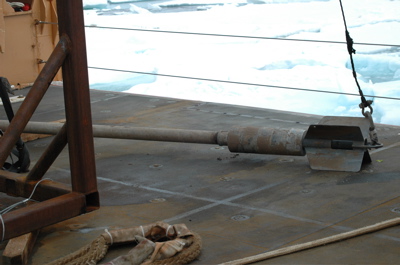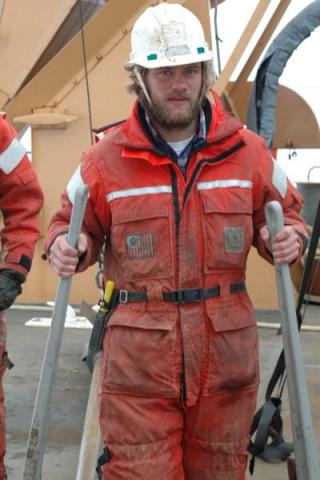( Log In ) Log In is for TREC Teachers & Researchers only
  |
| Steve_Stevenoski |
 Aug 18 2006, 03:41 AM Aug 18 2006, 03:41 AM
Post
#1
|
|
Member   Group: TREC Team Posts: 27 Joined: 19-July 06 Member No.: 39 |
August 13, 2006
What makes Sunday different than most days of the week is that the only time you really see the Coasties is at meals. Sunday is as close to a day of as most of the crew get. If they have a job that involves them in helping with the science, Sunday is like any other workday. During normal ship hours, you will pass people in the halls and on the stairs just about any time of the day or night. Sunday is quiet with most of the crew taking advantage of the extra time to get some needed personal and quiet time. Benthos Corer  At about 9:30, I talked with Larry Lawver about the plan for the day. Most of the ship time would be devoted to transiting and coring. Along the ridge are some small depressions between 100 and 300 meters across. These pockmarks are associated with regions in the crust that contain high concentrations of gases. These gases are typically methane or carbon dioxide. The rocks that contain the gases are called gas hydrates or clathrates. In either case, the gases that are stored in the rocks can give a clue to the history of the crust in the area. Gases are typically the result of two processes. Biogenetic processes produce gas through the normal life processes of microscopic organisms. The gas that is produced as a waist product is stored in the saturated spaces in the rock. Thermo genetic processes produce gas through the application of heat to different types of rock that produced a chemical change that releases gas as a waste product that can also get stored in the spaces in the rock. Viewing Pockmark  One of the regions to core these areas is to try to determine the origin and type of gases stored in the rock in these pockmarks. On the Knudsen, the pockmarks look like a depression on the otherwise flat seafloor. What makes the pockmarks identifiable as gas rich areas is that on the surface the layers of the upper crust form a single layer and below the depression you see an arch shaped feature just below the crust. As we transited, these features regularly appear in the area of the Mendelev Ridge where we plan to do seismic work in the next couple of days. It should take about a half hour to prepare the benthos core for deployment. The big time consumer in the coring process is the time it takes to send the core down and bring it up. The corer is typically lowered at 60 meters per minute. The area we will be sampling is between 800 and 1000 meters deep. Up and down will take about a half hour total. We should be able to take a core an hour once we get to our first coring station. At 2:00 we were at our first coring station. By 2:30, we were lowering the first Benthos core off the fantail. The ship was allowed to drift once we came on station. The ship would be positioned on one side of the pockmark and allowed to drift across to the other side. When the ship was over the center of the pockmark, the corer would be dropped the final few tens of meters to take the sample. To insure that we were over the center, Larry Lawver and Larry Phillips would monitor the Knudsen to get real time positioning of the ship relative to the feature they were sampling. Tools of the Trade  The cores were about 1.5 meters long. Larry Phillips had some special containers that he used to collect the lower portion of the core. These containers allowed him to preserve any gases that were dissolved in the sediments. Later these sediments could be chemically tested to determine the concentration and types of gases present. Typically Larry looks at the sediment to identify the different type of foraminifera fossils present. In addition to these small fossils they also found bivalve shells on the top of the column. At this time they are not sure why they found them on this core and not any of the others. We started south to look for good ice along the Mendeleev Ridge where we could deploy the seismic instruments. Tentatively we would start deploying the instruments on the ice at about 6:00 am tomorrow morning. To see the ice conditions that the ship is working in you can visit this website. It updates the view from the aloftcon every two minutes. http://mgds.ldeo.columbia.edu/healy/photos/aloftcon/2006/ |
  |
1 User(s) are reading this topic (1 Guests and 0 Anonymous Users)
0 Members:

|
NSF Acknowledgment & Disclaimer | Time is now: 19th November 2024 - 06:12 PM |
Invision Power Board
v2.1.7 © 2024 IPS, Inc.








